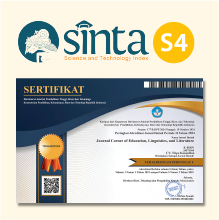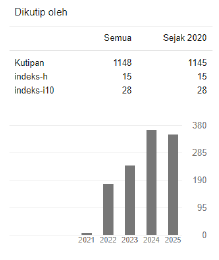Teachers’ Written Corrective Feedback Strategies Through the Lens of the Students
 https://doi.org/10.54012/jcell.v3i2.227
https://doi.org/10.54012/jcell.v3i2.227
 Abstract views: 2381
Abstract views: 2381
 PDF downloads: 731
PDF downloads: 731
Keywords:
education, descriptive-qualitative, thematic analysis, students, interview, PhilippinesAbstract
This descriptive-qualitative study was conducted to venture the written corrective feedback strategies employed by the College of Teacher Education teachers in a private university in Davao City, Philippines. The study utilized thematic analysis to analyze the data gathered from the in-depth interviews of eight selected participants through a purposive sampling technique. The data revealed teachers' seven written corrective feedback strategies: lexical written feedback, grammatical written feedback, organization in writing, motivating written feedback, metalinguistic feedback, and verification feedback. Additionally, this study uncovered the impact of written corrective feedback strategies, namely improvement of lexical skills, improvement of sentence structure, improvement of grammatical skills, development of the organization in writing, enhancement of self-regulation, a decrease of the affective filter, and improvement of learning productivity. The results of this study presented various written corrective feedback strategies for the teachers. It also unveiled the implications of the strategies employed. Hence, it is gainful for the administrators and teachers because they will be encouraged to use the strategies found in the study and practice them in the academe. It will also contribute to the students in a way that they will value the feedback.
Downloads
References
Afify, M.K. (2018). The Impact of Interaction between Timing of Feedback Provision
in Distance E-Learning and Learning Styles on achieving Learning Outcomes
among Arab Open University Students. https://doi.org/10.29333/ejmste/91619
Agbayahoun J.P. (2016). Teacher Written Feedback on Student Writing: Teachers’
and Learners’ Perspectives. http://dx.doi.org/10.17507/tpls.0610.01
Amoli, A.F. (2022). The Effect of Oral Metalinguistic Corrective Feedback on
Learners’ Knowledge of Pronoun among Iranian EFL Learners. DOI:
http://dx.doi.org/10.17507/tpls.1006.07
Brooks, L. (2021). Classroom productivity: 5 Incredible ways to increase it. Retrieved
from https://happyproject.in/classroom-productivity/.
Caduceus International Publishing. (2021, April 9). Combatting Lack of Motivation in
Online Learning. https://www.cipcourses.com/combatting-lack-of-motivation-
in-online-learning/
Canals, L., Granena, G., Yilmaz, Y., & Malicka, A. (2020). Second Language
Learners’ and Teachers’ Perceptions of Delayed Immediate Corrective Feedback
in an Asynchronous Online Setting: An Exploratory Study.
https://files.eric.ed.gov/fulltext/EJ1288929.pdf
Coman, C., T, îru, L.G., Schmitz, L.M., Stanciu, C., &Bularca M.C. (2020). Online
Teaching and Learning in Higher Education during the Coronavirus Pandemic:
Students’ Perspective.
Creswell J., & Plano Clark V (2011). Designing and conducting mixed method
research. 2nd Sage; Thousand Oaks, CA: 2011.
Delahunt, B., & Maguire, M. (2017). Doing a thematic analysis: A practical step-by-
step guide for learning and teaching scholars.
https://ojs.aishe.org/index.php/aishe-j/article/view/335.
Demira, Y. & Sarsarb, F. (2021). The effectiveness of emotional motivational feedback
messages via online assignments in information technologies and software
course academic achievement. Journal of Educational Technology & Online
Learning, 4(2), 280-292.
Dworkin S. (2012). Sample Size Policy for Qualitative Studies Using In-depth
Interviews.
Fu, M. (2019). The associations between individual differences in working memory
and the effectiveness of immediate and delayed corrective feedback.
DOI:10.1075/¬jsls.19002.fu.
Gan, Z., An, Z., & Liu, F. (2021). Teacher Feedback Practices, Student Feedback
Motivation, and Feedback Behavior: How Are They Associated With Learning
Outcomes? Frontiersin psychology, 12, 697045.
https://doi.org/10.3389/fpsyg.2021.697045
Ganapathy, M., Phan, J., & Tan, D. (2020). Impact of written feedback on Malaysian
ESL secondary students’ writing performance. 10.17576/3L-2020-2603-11.
Goskoy, A.S., &Nazli, O.P. (2016). The effect of direct and indirect written corrective
feedback on students’ writing.https://dergipark.org.tr/tr/download/article-
file/349051
Harding, S.M., Galvao de-Barba, P., & Goh, F. (2016). Teaching self-regulated
learning skills. Retrieved from
https://www.teachermagazine.com.au/articles/teaching-self-regulated-
learning-skills
Henderson M. (2017). Universities are Failing their students through Poor Feedback
Practices. https://theconversation.com/amp/universities-are-failing-their-
studies-through-poor-feedback-practices-86756.
Huang R., Lehman, J. Lu, H. Tlili, A. & Wang, H. (2021). Investigating feedback
implemented by instructors to support online competenct-based learning (CBL): a
multiple case study. https://doi.org/10.1186/s41239-021-00241-6
Irwin, B. (2017). Written Corrective feedback: Student preferences and teacher
feedback practices. Volume 3 – Issue 2 – AFOR Journal of Language Learning
Jennings, D. (2021). How to Write Better by Improving Your Sentence Structure.
https://study.com/academy/lesson/howtowritebetterbyimprovingyoursenten
cestructure.html#:~:text=Good%20sentence%20structure%20makes%20your,
modifiers%20in%20the%20wrong%20place
Kao., C.,C., (2019). Development of Team Cohesion and Sustained Collaboration
Skills with the Sport Education Model. Retrieved from sustainability-11-02348
(1).pdf
Kim H, Sefcik JS, Bradway C. (2017) Characteristics of qualitative descriptive studies:
A systematic review. Research in Nursing & Health 40: 23–42.
Lanka, E., Lanka, S., Rostron, A. & Singh, P (2021). Why We Need Qualitative
Research in Management Studies. https://doi.org/10.1590/1982-
rac2021200297.en.
Lira-Gonzales, M.L., & Nassaji, H. (2020). The Amount and Usefulness of Written
Corrective Feedback Across Different Educational Contexts and Levels.
https://doi.org/10.18806/tesl.v37i2.1333
Meşe, E. &Sevilen, Ç. (2021). Factors influencing EFL students’ motivation in online
learning: A qualitative case study. Journal of Educational Technology & Online
Learning, 4(1), 11-22.
Mohammad, T., & Rahman, T. (2016). English Learners Perception on Lecturers’
Corrective Feedback. http://www.theartsjournal.org/index.php/site/index.
Nordquist, R. (2019). Lexical Meaning (Words). Glossary of Grammatical and
Rhetorical Terms. https://www.thoughtco.com/lexical-meaning-words-
Nordquist, R. (2018). What is cohesion in composition? Retrieved from
https://www.thoughtco.com/what-is-cohesion-composition-1689863
Pearson. (2016). Proving Educational Feedback. Retrieved from
https://www.pearson.com/content/dam/onedotcom/onedotcom/us/
en/pearson-ed/downloads/Feedback.pdf
Rabidoux S., &Rottmann A. (2017). How to Provide Meaningful Feedback Online.
https://www.insidehighered.com/digital-learning/views/2017/09/06/how-
provide-meaningful-feedback-online-course.
Surber, K. (2021). What is Structure in Writing and How does it Affect Meaning?
https://study.com/academy/lesson/what-is-structure-in-writing-and-how-does-
it-affect-meaning.html
Rodgers, Linda. (2019). The Effects of Giving Effective Feedback Strategies in
Reading with Elementary Students. Retrieved from Sophia, the St. Catherine
University repository website: https://sophia.stkate.edu/maed/331
Rouhi, A., Dibah, M., & Mohebbi, H. (2020). Assessing the effect of giving and
receiving written corrective feedback on improving L2 writing accuracy: does
giving and receiving feedback have fair mutual benefit?.DOI:10.1186/s40862-
-00093-z
Tseng, C.H. (2018). Delayed Effect of Teachers’ Error Correction on EFL Students’
Ability in Self Correction in Writing: A Case Study. doi:10.30845/ijll.v5n4p20
Thananchai, P., & Padgate, W. (2018). The effects of direct and indirect corrective
feedback on grammatical improvement in journal writing of grade 9 students
in a thai school. Journal of Education and Social Sciences, Vol. 11, Issue 1,
(October) ISSN 2289-9855
Tamm, S. (2020). 10 Biggest Disadvantages of E-learning.
https://e-student.org/disadvantages-of-e-learning/#online-student-feedback-is-
limited
Tamayo, M.R., &Cajas, D. (2017). Strategies of Metalinguistic and Recast Feedback
during Oral interactions. https://doi.org/10.14483/22487085.11315 .
Wei W, Cao Y (Katherine). Written Corrective Feedback Strategies Employed by
University English Lecturers: A Teacher Cognition Perspective. SAGE Open.
July 2020. doi:10.1177/2158244020934886
Yi, D. (2021). The Effects of Immediate Versus Delayed Teacher Feedback on L2
Writing. DOI:10.22158/¬selt.v9n3p69
Yu, M., Wang, H., & Xia, G. (2022). The Review on the Role of Ambiguity of
Tolerance and Resilience on Students’ Engagement. 10.3389/¬
fpsyg.2021.828894
Zarei, A.A., & Mousavi, M. (2016). The Effects of Feedback Types on Learners'
Recognition of Lexical Collocations.
http://dx.doi.org/10.7575/aiac.ijalel.v.5n.2p.150
Zhan, L. (2016). Written Teacher Feedback: Student Perceptions, Teacher Perceptions,
and Actual Teacher Performance. English Language Teaching, v9 n8 p73-84
Zhang, T., Chen, X., Hu, J., &Ketwan, P. (2021). EFL Students' Preferences for
Written Corrective Feedback: Do Error Types, Language Proficiency, and
Foreign Language Enjoyment Matter?
Downloads
Published
How to Cite
Issue
Section
License
Copyright (c) 2023 Christian Jay, John Rick Malisobo, Marivic Salce, Michael Roasol

This work is licensed under a Creative Commons Attribution-ShareAlike 4.0 International License.
All articles published in the Journal Corner of Education, Linguistics, and Literature are licensed under the Creative Commons Attribution-ShareAlike License (CC BY-SA).

















